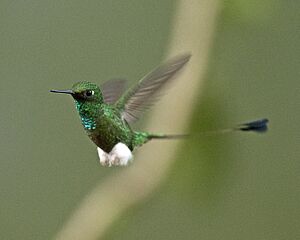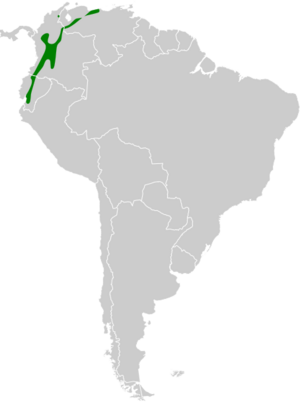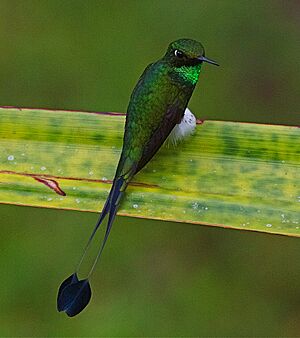White-booted racket-tail facts for kids
Quick facts for kids White-booted racket-tail |
|
|---|---|
 |
|
| Conservation status | |
| Scientific classification | |
| Genus: |
Ocreatus
|
| Species: |
underwoodii
|
 |
|
The white-booted racket-tail (Ocreatus underwoodii) is a tiny, colorful hummingbird found in Colombia, Ecuador, and Venezuela. It's known for the male's unique long tail feathers that look like little rackets! These birds are part of a group called "brilliants."
Contents
About This Bird's Family
Scientists group animals into families and species. The white-booted racket-tail is a type of hummingbird. Different groups of scientists sometimes classify these birds in slightly different ways.
Some scientists think there are five main types, or subspecies, of the white-booted racket-tail. Other groups believe there are more. These subspecies are:
- O. u. polystictus
- O. u. discifer
- O. u. underwoodii
- O. u. incommodus
- O. u. melanantherus
What Does It Look Like?
White-booted racket-tails look different depending on if they are male or female. This is called sexual dimorphism. Only the male birds have very long outer tail feathers. These feathers have thin shafts with oval shapes, called "flags," at the very end. These flags look a bit like tiny tennis rackets!
Both male and female birds have white, fluffy feathers on their legs, which look like little "boots." Their upper bodies are green. Males have a greenish-gray throat and a solid green belly.
Male white-booted racket-tails are about 11 to 15 centimeters (4.3 to 5.9 inches) long. This includes their long tail feathers, which can be 7 to 8 cm (2.8 to 3.1 inches) long. They weigh about 2.5 to 2.7 grams (0.088 to 0.095 ounces). Females are smaller, about 7.6 to 9 cm (3.0 to 3.5 inches) long, and weigh 2.6 to 3.2 grams (0.092 to 0.11 ounces).
The different subspecies of male white-booted racket-tails have tail flags that vary in color and shape. Female subspecies differ in the pattern of green spots on their white throat and belly.
Where Do They Live?
The white-booted racket-tail lives in the Andes mountains in South America. You can find them in parts of Colombia, Ecuador, and Venezuela.
Each subspecies lives in a specific area:
- O. u. polystictus lives in the Venezuelan Coastal Range.
- O. u. discifer is found in northwestern Venezuela and northern Colombia.
- O. u. underwoodii lives in Colombia's Eastern Andes.
- O. u. incommodus is in Colombia's Central and Western Andes.
- O. u. melanantherus lives on the Pacific side of the Andes, from Colombia to southwestern Ecuador.
These birds like to live in humid or wet forests, especially at the edges. They can also be found inside forests or in areas where forests are regrowing. They usually live at elevations between 1,600 and 2,200 meters (5,200 and 7,200 feet) high. However, they can sometimes be seen as low as 600 m (2,000 ft) or as high as 4,000 m (13,000 ft).
How They Live
Movement
White-booted racket-tails sometimes move to different elevations after they have finished breeding. This means they might fly up or down the mountains depending on the season.
Feeding
These hummingbirds usually look for food between 6 and 18 meters (20 and 59 feet) above the ground. They drink nectar from many different types of flowers. Sometimes, several birds will feed close together. Besides nectar, they also catch small insects. They do this by waiting on a perch and then flying out to grab insects in the air. This is called hawking.
Life Cycle
White-booted racket-tails breed at least from January to April in Colombia. However, they might breed at any time of the year. The female builds a tiny cup-shaped nest using plant fibers and lichen. She usually places it on a horizontal twig about 6 to 8 meters (20 to 26 feet) above the ground.
The female lays two eggs and keeps them warm for 16 to 17 days. The young birds leave the nest, or fledge, about 19 to 22 days after they hatch.
Vocalization
Both male and female white-booted racket-tails make a special sound. It's a sweet, descending trill that sounds like "ti-tlee-ee-ee." They also make single "tsit" and "trrt" notes.
Conservation Status
The white-booted racket-tail is currently listed as a species of "Least Concern" by the IUCN. This means that it is not considered to be in danger of disappearing. It lives in a large area, and even though its exact population size isn't known, scientists believe it is stable. There are no immediate threats to this bird. It is a very common species and lives in several protected areas.



